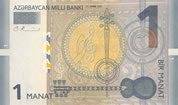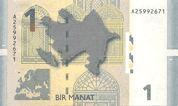阿塞拜疆马纳特
出自 MBA智库百科(https://wiki.mbalib.com/)
阿塞拜疆马纳特(Azerbaijani manat/Azərbaycan manatı (Azerbaijani) 标准符号:AZN ISO 4217现行通用三位字母代码:AZM)ISO 4217 Code:AZN
User(s):Azerbaijan except Nagorno-Karabakh
Inflation:11.5%
Source:National Bank of Azerbaijan, November, 2006
Method:CPI
Subunit:1/100 qəpik
Symbol:m, ман. or man.
Coins:1, 3, 5, 10, 20, 50 qəpik
Banknotes:1, 5, 10, 20, 50, 100 manat
Central bank:National Bank of Azerbaijan
Website:http://www.nba.az
The manat (currency code: AZN) is the currency of Azerbaijan. It is subdivided into 100 qəpik. The word manat is borrowed from the Russian word "монета" (coin) which is pronounced as "maneta". Manat was also the designation of the Soviet ruble in both the Azerbaijani and Turkmen languages.
First Manat, 1919-1923
The Democratic Republic of Azerbaijan and the Azerbaijani Soviet Socialist Republic issued their own currency between between 1919 and 1923. This currency was called the manat (منات) in Azerbaijani and the ruble (рубль) in Russian, with both language appearing on the banknotes. The manat replaced the first Transcaucasian ruble at par and was replaced by the second Transcaucasian ruble after Azerbaijan became part of the Transcaucasian Soviet Federal Socialist Republic. No subdivisions were issued and the currency only existed as banknotes. The Democratic Republic issued notes in denominations between 25 and 500 manat, whilst the ASSR issued notes in denominations between 5 and 5 million manat.
Second Manat, 1992-2006
The second manat was introduced on 15 August, 1992.[1] It had the ISO 4217 code AZM and replaced the Russian ruble at a rate of 10 rubles to 1 manat.
From early 2002 to early 2005, the exchange rate was fairly stable (varying within a band of 4770–4990 manat per US dollar). Starting in the spring of 2005 there was a slight but steady increase in the value of the manat against the US dollar; the reason most likely being the increased flow of petrodollars into the country, together with the generally high price of oil on the world market. At the end of 2005, one dollar was worth 4591 manat. Banknotes below 100 manat had effectively disappeared by 2005, as had the qəpik coins.
Coins were issued in denominations of 5, 10, 20 and 50 qəpik, dated 1992 and 1993. Although brass and cupro-nickel were used for some of the 1992 issues, later issues were all in aluminium.
The following banknotes were issued for this currency
- 1, 5, 10, 250 manat (all first issued in 1992)
- 50, 100, 500, 1000 manat (all first issued in 1993)
- 10,000 manat (first issued in 1994)
- 50,000 manat (first issued in 1996)
Banknotes with denominations from 1 to 250 manat featured Baku's Maiden Tower.
Third Manat, 2006-
On 1 January 2006, a new manat (ISO 4217 code AZN, also called the "manat (national currency)") was introduced at a value of 5000 old manat. Since 1 October 2005, prices have been indicated both in new manats and in old manats to ease transition. Coins denominated in qəpik, which had not been used from 1993 onwards due to inflation, have been reintroduced with the redenomination.
The former manat (ISO code 4217 AZM) remained valid till 31 December 2006. [2]
One U.S. dollar is currently (as of 2006) worth 0.918 Azerbaijani manat.
Coins
Coins in circulation are 1, 3, 5, 10, 20 and 50 qəpik (the latter being bimetallic, similar to the €2 coin)
Banknotes
Banknotes in circulation are 1, 5, 10, 20, 50 and 100 manat. They were designed by Austrian Robert Kalina, who was also responsible for the current euro banknotes. The notes look quite similar to those of the euro and the choice of motifs was inspired by the euro banknotes.
The 1 manat banknote symbolizes Azerbaijan's rich traditional and modern culture. It depicts images of Azerbaijani folk musical instruments on the obverse, with ornaments of ancient Azerbaijani carpets on the reverse.
The 5 manat banknote symbolizes Azerbaijan’s valuable contribution to the world literature. On the obverse, it depicts ancient writers, poets, and books from Azerbaijan, while the reverse pictures rock drawings of Qobustan, samples of Orkhon script and letters from the contemporary Azerbaijani alphabet.
The 10 manat banknote symbolizes Azerbaijan’s ancient traditions of statehood and its rich history, depicting images of old Baku, the Palace of the Shirvanshahs and the Maiden Tower against a background of the Icheri Sheher wall on the obverse; on the reverse, ornaments of ancient Azerbaijani carpets and a map showing Azerbaijans integration into Europe can be seen.
The 20 manat banknote symbolizes the major goal of current Azerbaijani foreign policy, the territorial integrity of Azerbaijan – i.e., the Nagorno-Karabakh issue with Armenia. On the obverse, signs of power are displayed (a sword, a helmet and a shield), while the symbol of peace (harybulbul) is depicted on the reverse, once again together with the map also shown on the 10 manat banknote.
The 50 manat banknote symbolizes Azerbaijan's education and its future, displaying youth, stairs (as a symbol of progress), the sun (as a symbol of force and light) and chemical and mathematical symbols (as signs of science) on the obverse, while the reverse once again shows the common features of Azerbaijani carpet ornaments and the European map.
Finally, the 100 manat banknote symbolizes Azerbaijan's economic development and its status as a flourishing nation. Architectural symbols from antiquity up to today, the manat currency symbol (a stylicized M) and symbols of economic growth are displayed on the obverse, while the common features (carpets and map) are shown on the reverse.





















